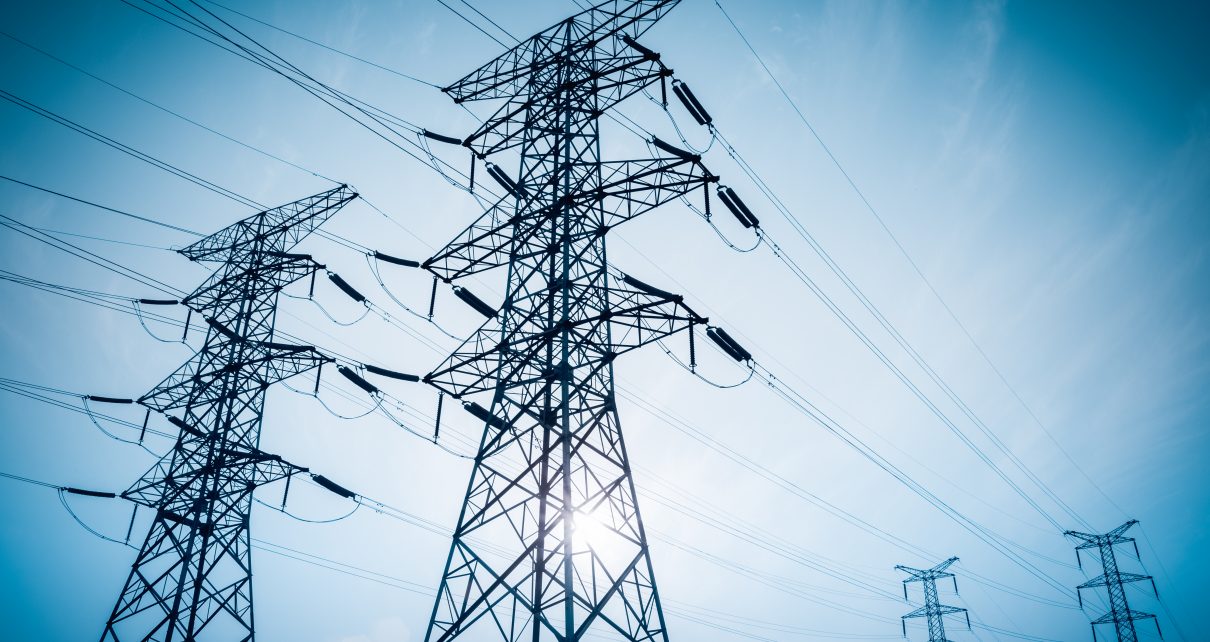
Electricity Transmission Pylon at Dusk. (Photo: chuyuss/Shutterstock)
Ringside: California’s Energy Economy – Challenges and Opportunities
The problem arises when considering the need to fast-charge EVs
By Edward Ring, July 12, 2024 2:45 am
 Two weeks ago, the first part of this series (Ringside, June 27) provided links to a few of the most useful and authoritative references available on energy use globally and in California: the Statistical Review of World Energy, Lawrence Livermore Laboratory’s Energy Flow Charts, fuel inputs to California from the U.S. Energy Information Administration, and reports on California energy use with a focus on electricity from the California Energy Commission.
Two weeks ago, the first part of this series (Ringside, June 27) provided links to a few of the most useful and authoritative references available on energy use globally and in California: the Statistical Review of World Energy, Lawrence Livermore Laboratory’s Energy Flow Charts, fuel inputs to California from the U.S. Energy Information Administration, and reports on California energy use with a focus on electricity from the California Energy Commission.
Providing an overview of California’s energy use by pointing to these core resources is a relatively straightforward exercise. Summarizing California’s energy challenges and opportunities is more subjective. With that disclaimer, the focus of this summary will be to explore how California may attempt to electrify its economy, highlighting a few of the good and bad options.
To continue where last week’s analysis left off, Californians consume roughly 7,000 “TBTUs” (Trillion British Thermal Units) of energy per year, and about 80 percent of the raw fuel input is either oil (50 percent) or natural gas (30 percent). About two-thirds of that raw fuel input is wasted in the form of friction, transmission loss, or dissipated heat, with one-third realized in the form of energy services – motion, lights, heating, cooling.
The opportunity presented by electrification rests on the fact that 90 percent or more of the electricity used to charge batteries can be released in discharge, and that 90 percent or more of the electricity used to power electric motors can be converted into actual horsepower. In general, devices that consume electricity such as electric vehicles and electric appliances – cooktop, heater, A/C – are more efficient than their combustion powered counterparts.
If electricity also can be produced more efficiently, it is possible the ratio of wasted energy to energy services can be flipped. That is, instead of seeing two thirds of raw fuel inputs wasted and only one-third turned into energy services, only one third will be wasted and two thirds will be utilized. If this is accomplished, California’s total required energy might drop from 7,000 TBTUs to 4,000 TBTUs or even less. But how does that compare to how much electricity Californians currently utilize?
Here’s where the first challenge arises. If all 4,000 TBTUs were realized in the form of electricity, that would equate to 134 gigawatt-years (1.2 million gigawatt-hours). Recall that last year, Californians consumed approximately 32 gigawatt-years (not quite 300,000 gigawatt-hours), and only produced two-thirds of them in-state. If Californians were to totally electrify their economy, electricity consumption could quadruple.
Don’t panic. This reality check is tempered by the fact that even more efficiency may be realized as technology advances, potentially further lowering the required energy inputs. And despite the ongoing and very passionate intentions of the state legislature, conversion to an all-electric economy is going to take decades. Unforeseen breakthroughs may render all of this much easier than we can currently imagine. But nonetheless, just to transition most of California’s transportation and residential sectors to use mostly electricity, consumption will need to nearly double, from 300,000 gigawatt-hours per year to 500,000 gigawatt-hours or more.
Probably the worst possible way to increase California’s electrical generating capacity is via the proposed floating offshore wind projects. As documented in WC #36, if this project moves from proposal to implementation, it will be a financial and ecological catastrophe. Fully realized, the 25 gigawatts of “nameplate capacity” will translate into a mere 10 gigawatts of usable baseload electricity; that’s only about 7 percent of what we’re going to need. It would require at least 2,500 floating offshore turbines and the construction will cost at least $300 billion. To verify that estimate, refer to this itemized description of costs. Don’t forget to convert to dollars, adjust for inflation, account for the source (a trade association that is organized to promote these projects), and add the expected premium that attends to doing anything in California. For further information, here is a recent report that offers the most well documented criticisms I’ve yet seen of offshore wind. For any politician to advocate floating offshore wind turbines off the California coast is disgraceful.
There are many alternatives to offshore wind energy, including nuclear, geothermal, small hydro, biomass, and solar. Even onshore wind, while still problematic, is vastly preferable to offshore wind. But hiding in plain sight is a solution that would permit Californians to immediately have access to cheap and abundant electricity. Keep California’s natural gas powerplants open, and run them at capacity.
As previously noted, California’s natural gas powerplants produced 96,000 gigawatt-hours last year, nearly 50 percent of in-state electricity generation. But those power plants only operated at 26 percent of capacity. If they were to capture and sequester 100 percent of their CO2 emissions, that would reduce their efficiency by around 10 percent. Taking that into account, and allowing for some downtime, it is reasonable to assume these plants could operate at 80 percent efficiency. If so, instead of generating 96,000 gigawatt-hours per year, they could generate 295,000 gigawatt-hours. Just this one change would bring California’s in-state power generation up to more than 400,000 gigawatt-hours per year. As we document in WC #35, using data from the U.S. Department of Energy, these retrofits could be done at a cost of around $40 billion. As for the room underground, a recent Stanford study assesses sufficient underground storage capacity in California to accommodate 100 percent of California’s natural gas power plant emissions (at full capacity) for the next 500 years.
Once upon a time, the prestigious World Watch magazine consistently referred to natural gas as the great “transitional fuel.” It would behoove California’s leadership to return to that common sense perspective, because it would enable our great electrification experiment to continue without a supply side disruption. But challenges would remain. Charging electric vehicles is an acute example.
The problem arises when considering the need to fast-charge EVs. Compared to the average home, which draws on average 1.25 kilowatt-hours per hour, to charge in 15 minutes, an EV with a 44 kilowatt- hour battery (200 mile range, 4.5 miles per kWh) would have to pull in 3 kilowatt-hours per minute. That means the transmission lines delivering power to that vehicle must be equipped to move electrons at a rate 150 times greater than is required for the average home. Even a slower in-home charger, requiring five hours instead of 15 minutes, would require a flow of electricity eight times greater than what residential power lines are currently designed to deliver. This challenge – upgrading every transmission line in the state to handle surges of this magnitude as EVs charge (and discharge) into California’s power grid, and you have a challenge that rivals and perhaps exceeds the challenge to simply generate more electricity.
These challenges will be met, and if there is anywhere on earth where they can be met, it’s here in California. We may only hope, however, that common sense will prevail as we choose which projects and priorities shall drive us into the future.
- Ringside: Reversing California’s Policies of Scarcity - January 8, 2026
- Ringside: What is the Future of California’s Republican Party? - December 31, 2025
- Ringside: CA GOP Just Blew $46 Million for Nothing – Here’s How They Can Avoid Repeating That Mistake in 2026 - December 24, 2025





Do we really need to capture the Co2 from the natural gas fired plants? What would the value/benefit be? At this stage of the game, I agree with your comments about California using multiple sources of electricity generation to meet our needs. What would happen to your numbers if he EV fad went away?
The point of the example is that anyone concerned about CO2 ought to be able to nonetheless see the huge environmental and economic advantage of restoring full capacity to our existing investment in natural gas power plants, instead of allowing thousands of insanely huge floating wind turbines befoul and industrialize our entire coast and coastal waters. Like nuclear power, natural gas power with sequestered emissions is a solution the climate lobby doesn’t accept. We should all be asking why not, as we allow them to bankrupt our people and desecrate our state with “renewables.”
Playing along with a game rigged for failure is utter foolishness. Greens are not in an “experiment” to electrify the world, they are in the process of de-industrialization and the extinction of the human race. CO2 sequestration is a really bad idea that will be far costlier than the intentionally low ball estimates that the cheerleaders quote. Eliminate the government mandates and subsidies for a failing technology (EV’s) and the whole problem goes away almost overnight. Consumers have figured out that EV’s are unviable yet the elites continue to push them. We need leaders who have the common sense of the average Joe on the street, not the dictates of elites that are devoted to enslaving the population. Trying to refine, tweak and improve an idea devoted to the destruction of civilization is insane.
CW I agree. At onetime Co2 was labeled a building block of life and the estimates are that it is 1% of the earth’s atmosphere. The current so called “experts” have been bought by the global elites. We need to get back to a more traditional role for science where it is not influenced by a nefarious crowd. California can easily power its future (without offshore windmills) if practicality and commonsense prevails. The same goes for an adequate supply of water for farmers people and nature.
FYI, CO2 is ~.04% of the atmosphere, and most of it is from natural sources.